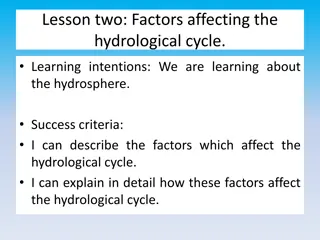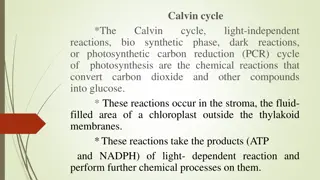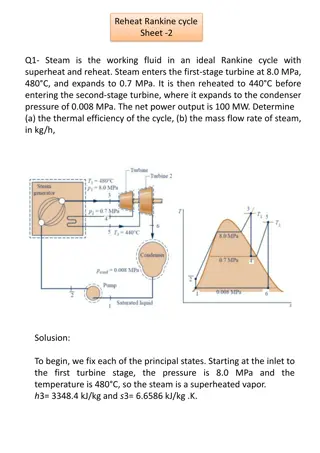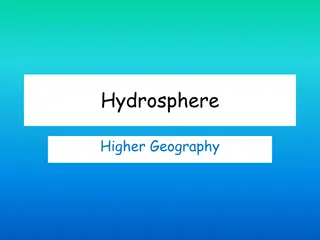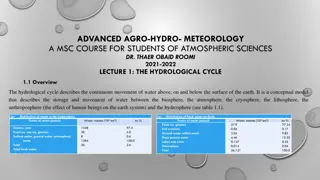
Understanding the Hydrological Cycle: Importance and Implications
Explore the hydrological cycle, the continuous movement of water on Earth's surface, through its stages like evaporation, sublimation, condensation, and precipitation. Learn about the significance and implications of this natural process.
Download Presentation

Please find below an Image/Link to download the presentation.
The content on the website is provided AS IS for your information and personal use only. It may not be sold, licensed, or shared on other websites without obtaining consent from the author. If you encounter any issues during the download, it is possible that the publisher has removed the file from their server.
You are allowed to download the files provided on this website for personal or commercial use, subject to the condition that they are used lawfully. All files are the property of their respective owners.
The content on the website is provided AS IS for your information and personal use only. It may not be sold, licensed, or shared on other websites without obtaining consent from the author.
E N D
Presentation Transcript
StudyMafia.Org Hydrological Cycle Submitted To: Submitted By: Studymafia.org Studymafia.org
Table Contents Definition Introduction Stages of Hydrological Cycle Implications of Hydrological Cycle Importance of Hydrological Cycle Conclusion 2
Definition The water cycle, also known as the hydrologic cycle or the hydrological cycle, describes the continuous movement of water on, above and below the surface of the Earth. 3
Introduction During this process, water changes its state from one phase to another, but the total number of water particles remains the same. In other words, if it were possible to collect and boil 100 gms of water, it will still retain a mass of 100 gms as steam. Likewise, if 100 gms of steam is collected and condensed, the resultant water would still weight 100 gms. 4
Stages of Hydrological Cycle Evaporation The sun is the ultimate source of energy, and it powers most of the evaporation that occurs on earth. Evaporation generally happens when water molecules at the surface of water bodies become excited and rise into the air. These molecules with the highest kinetic energy accumulate into water vapour clouds. Evaporation usually takes place below the boiling point of water. 6
Stages of Hydrological Cycle Sublimation Sublimation occurs when snow or ice changes directly into water vapour without becoming water. It usually occurs as a result of dry winds and low humidity. Sublimation can be observed on mountain peaks, where the air pressure is quite low. The low air pressure helps to sublimate the snow into water vapour as less energy is utilised in the process. 7
Stages of Hydrological Cycle Condensation The water vapour that accumulated in the atmosphere eventually cools down due to the low temperatures found at high altitudes. These vapours become tiny droplets of water and ice, eventually coming together to form clouds. 8
Stages of Hydrological Cycle Precipitation Above 0 degrees centigrade, the vapours will condense into water droplets. However, it cannot condense without dust or other impurities. Hence, water vapours attach itself on to the particle s surface. When enough droplets merge, it falls out of the clouds and on to the ground below. This process is called precipitation (or rainfall). 9
Stages of Hydrological Cycle Infiltration Rainwater gets absorbed into the ground through the process of infiltration. The level of absorption varies based on the material the water has seeped into. For instance, rocks will retain comparatively less water than soil. Groundwater can either follows streams or rivers. But sometimes, it might just sink deeper, forming aquifers. 10
Stages of Hydrological Cycle Runoff If the water from rainfall does not form aquifers, it follows gravity, often flowing down the sides of mountains and hills; eventually forming rivers. This process is called runoff. In colder regions, icecaps form when the amount of snowfall is faster than the rate of evaporation or sublimation. 11
Implications of Hydrological Cycle The water cycle has a tremendous impact on the climate. For instance, the greenhouse effect will cause a rise in temperature. Without the evaporative cooling effect of the water cycle, the temperature on earth would rise drastically. The water cycle is also an integral part of other biogeochemical cycles. 12
Implications of Hydrological Cycle Water cycle affects all life processes on earth. The water cycle is also known the clean the air. For instance, during the process of precipitation, water vapours have to attach themselves on to particles of dust. In polluted cities, the raindrops, apart from picking up dust, also pick up water-soluble gas and pollutants as they fall from the clouds. 13
Importance of Hydrological Cycle Water cycle has a huge impact on determining the global climate. It is also an integral part of other biogeochemical cycles. It affects all life processes on Earth either directly or indirectly. 14
Conclusion The hydrologic cycle involves the continuous circulation of water in the Earth-Atmosphere system. At its core, the water cycle is the motion of the water from the ground to the atmosphere and back again. Of the many processes involved in the hydrologic cycle, the most important are... evaporation. transpiration. 16
Thanks To StudyMafia.org


